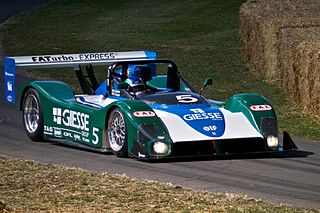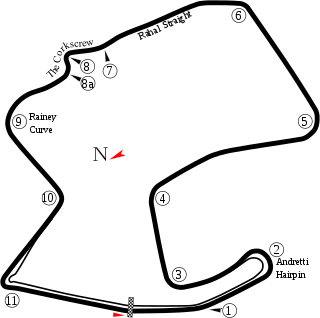Season results
Overall winner in bold.
The 1963 United States Road Racing Championship season was the first season of the Sports Car Club of America's United States Road Racing Championship. It began February 3, 1963, and ended September 22, 1963, after eight races. Separate races for sportscars and GTs were held at four rounds, while three rounds were combined races, and one round (Daytona) was for sportscars only. Bob Holbert won the season championship, splitting time between the under-two liter sportscar and GT classes.
| Rnd | Race | Length | Class | Circuit | Location | Date |
|---|---|---|---|---|---|---|
| 1 | Daytona 200 | 200 mi (320 km) | Sports | Daytona International Speedway | Daytona Beach, Florida | February 3 |
| 2 | USRRC Pensacola | 150 mi (240 km) | GT | Corry Field | Pensacola, Florida | May 26 |
| 260 mi (420 km) | Sports | |||||
| 3 | Laguna Seca 150 | 150 mi (240 km) | All | Laguna Seca Raceway | Monterey, California | June 9 |
| 4 | Watkins Glen Sports Car Grand Prix | 150 mi (240 km) | GT | Watkins Glen Grand Prix Race Course | Watkins Glen, New York | June 30 |
| 300 km (190 mi) | Sports | |||||
| 5 | Pacific North West Grand Prix | 150 mi (240 km) | GT | Pacific Raceways | Kent, Washington | July 21 |
| 150 mi (240 km) | Sports | |||||
| 6 | Continental Divide 150 | 150 mi (240 km) | All | Continental Divide Raceway | Castle Rock, Colorado | August 18 |
| 7 | Road America 500 | 500 mi (800 km) | All | Road America | Elkhart Lake, Wisconsin | September 8 |
| 8 | USRRC Mid-Ohio | 270 km (170 mi) | GT | Mid-Ohio Sports Car Course | Lexington, Ohio | September 22 |
| 270 km (170 mi) | Sports |
Overall winner in bold.

Sports car racing is a form of motorsport road racing which utilises sports cars that have two seats and enclosed wheels. They may be purpose-built prototypes or grand tourers based on road-going models. Sports car racing is one of the main types of circuit auto racing, alongside open-wheel racing, touring car racing and stock car racing. Sports car races are often, though not always, endurance races that are run over particularly long distances or large amounts of time, resulting in a larger emphasis on the reliability and efficiency of the car and its drivers as opposed to outright car performance or driver skills. The FIA World Endurance Championship is an example of a sports car racing series. In the high-stakes world of sports car racing, drivers don specialized fire-resistant, aerodynamic racing suits, ensuring both comfort and safety during the demanding endurance races, as exemplified by the FIA World Endurance Championship.

The European Le Mans Series is a European sports car racing endurance series inspired by the 24 Hours of Le Mans race and organized by the Automobile Club de l'Ouest (ACO). The European Le Mans Series is similar to the former American Le Mans Series (ALMS) based in the United States and Canada that was running with ACO and IMSA between 1999 and 2013. ELMS team champions and runners-up receive an automatic entry to the following year's 24 Hours of Le Mans. Originally titled the Le Mans Endurance Series before becoming simply the Le Mans Series in 2006, the series was renamed once more in 2012, reusing a name previously utilized by IMSA in 2001.

A Le Mans Prototype (LMP) is a type of sports prototype race car used in various races and championships, including the 24 Hours of Le Mans, FIA World Endurance Championship, IMSA SportsCar Championship, European Le Mans Series and Asian Le Mans Series. Le Mans Prototypes were created by the Automobile Club de l'Ouest (ACO). The technical requirements for an LMP include bodywork covering all mechanical elements of the car. As of 2023, there are two classes within Le Mans Prototypes, designated LMP2 and LMP3.

The Ferrari 333 SP is a sports prototype race car that was built by Italian race car manufacturer Dallara and later Michelotto to compete in the World Sports Car championship for Ferrari. Unveiled at the end of 1993, at the behest of amateur racer Giampiero Moretti, the 333 SP marked Ferrari's official return to sports car racing after a 20-year absence. The car was built to compete in the IMSA's new WSC class, which replaced the previous GTP cars.

The World Sportscar Championship was the world series run for sports car racing by the FIA from 1953 to 1992.
The 1971 International Championship for Makes season was the 19th season of FIA World Sportscar Championship motor racing. It was open to Group 6 Sports Prototypes, Group 5 Sportscars, and Group 4 Special GT Cars and was contested over an eleven race series which ran from 10 January to 24 July 1971. Porsche won the championship, and the German manufacturer also won the International Cup for GT Cars.
The FIA Sportscar Championship was a sports car racing series created by John Mangoletsi and got the approval of the Fédération Internationale de l'Automobile (FIA) in 2001. It was a series similar to the FIA GT Championship, concentrating on two classes of open-cockpit sports prototypes in endurance races mostly around Europe. The series was folded after the 2003 season.

The Rolex Sports Car Series was the premier series run by the Grand American Road Racing Association. It was a North American-based sports car series founded in 2000 under the name Grand American Road Racing Championship to replace the failed United States Road Racing Championship. Rolex took over as series sponsor in 2002.
The United States Road Racing Championship (USRRC) was created by the Sports Car Club of America in 1962. It was the first SCCA series for professional racing drivers. SCCA Executive Director John Bishop helped to create the series to recover races that had been taken by rival USAC Road Racing Championship, a championship that folded after the 1962 season. For its first three seasons, the series featured both open-topped sports cars and GT cars. Ford and Porsche dominated the Over- and Under-2 Liter classes, respectively. The USRRC ran from 1963 until 1968 when it was abandoned in favor of the more successful Can-Am series, which was also run by the SCCA.

The Lola B2K/40 was a Le Mans Prototype developed in 2000 by Lola Cars International as a cheaper, smaller, and lighter alternative to the similar Lola B2K/10. Although specifically designed to compete in the SR2 class of the Sports Racing World Cup and Grand American Road Racing Championship, it would later be adapted to the LMP675 and LMP2 classes for the 24 Hours of Le Mans and American Le Mans Series. This design was replaced in 2005 by the Lola B05/40 and would last be used in competition in 2006.
The 2000 Grand American Road Racing Championship was the inaugural season of the Grand American Road Racing Championship run by the Grand American Road Racing Association. The season involved five classes: Sports Racing Prototypes I and II and three Grand Touring classes referred to as GTO, GTU, and AGT. 9 races were run from February 5, 2000 to August 17, 2000.
The 1999 United States Road Racing Championship was the second and final season of the revived United States Road Racing Championship run by the Sports Car Club of America (SCCA). The season involved four classes: Can-Am prototypes and three Grand Touring classes referred to as GT2, GT3, and GTT. Five races were scheduled from January 30, 1999, to October 2, 1999, but the series was cancelled after three rounds on June 6, 1999.

The Six Hours of Watkins Glen is a sports car endurance race held annually at Watkins Glen International in Watkins Glen, New York. The race dates from 1948, and has been a part of the SCCA National Sports Car Championship, United States Road Racing Championship, World Sportscar Championship, IMSA GT Championship, Rolex Sports Car Series and currently the IMSA WeatherTech SportsCar Championship.

The Riley & Scott Mark III was a sports prototype auto racing car developed by Bob Riley, Bill Riley and Mark Scott of Riley & Scott Cars Inc. Initially designed in 1993, the car was created for the World Sports Car (WSC) category which was to debut in the North American IMSA GT Championship during their 1994 season. It was not until 1995 that the first Mk III was completed, but the construction of further cars allowed a variety of teams to campaign in several North American and European racing series, including competing at the 24 Hours of Le Mans.
The 1966 United States Road Racing Championship season was the fourth season of the Sports Car Club of America's United States Road Racing Championship. It began April 24, 1966, and ended September 4, 1966, after eight races. GT cars were dropped from the program; only the two sports car classes were run. Chuck Parsons won the season championship.
The 1965 United States Road Racing Championship season was the third season of the Sports Car Club of America's United States Road Racing Championship. It began April 11, 1965, and ended September 5, 1965, after nine races. Separate races for sportscars and GTs were held at two rounds, while seven rounds were combined races. George Follmer won the season championship driving in the Under-2 Liter class.
The 1964 United States Road Racing Championship season was the second season of the Sports Car Club of America's United States Road Racing Championship. It began March 1, 1964, and ended September 13, 1964, after ten races. A second GT class for cars under two liters of displacement was added. Separate races for sportscars and GTs were held at eight rounds, while two rounds were combined races. Jim Hall won the season championship.

Bridgehampton Race Circuit was a race track located near Sag Harbor, New York, United States. The circuit opened in 1957, following a series of road races held from 1949 until 1953. It was one of the first permanent road racing venues in the United States, opening after Thompson Speedway, two years after Road America, the year after Watkins Glen International, and the same year as Lime Rock Park and Laguna Seca Raceway. In its early years, Bridgehampton was host to major international series, including the World Sportscar Championship, Can-Am, and NASCAR Grand National. By the early 1970s, the track was used mostly for amateur events. The track closed permanently in 1999.

The Course de Monterey is a sports car race held annually at WeatherTech Raceway Laguna Seca by the International Motor Sports Association (IMSA). The event began in 1950 as a race on the roads of Pebble Beach, California. In 1951, it was added to the new SCCA National Sports Car Championship. When Laguna Seca Raceway was built in 1957, the races moved there. The event fell dormant after the National Championship was discontinued in 1957, but was revived by the SCCA's new United States Road Racing Championship in 1963. The race fell dormant again in 1969, and was revived in 1973 with the IMSA GT Championship.